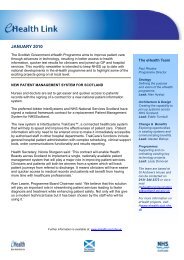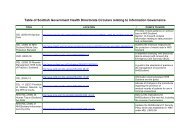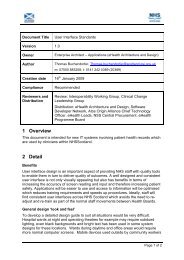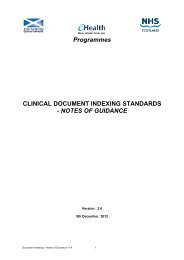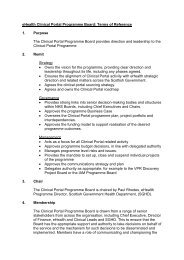ehealth - Programmes - Full Business Case Guide
ehealth - Programmes - Full Business Case Guide
ehealth - Programmes - Full Business Case Guide
Create successful ePaper yourself
Turn your PDF publications into a flip-book with our unique Google optimized e-Paper software.
Want to see a completed example?To see an example of a completed Benefits scores see <strong>Guide</strong> <strong>Business</strong><strong>Case</strong> Tables Examples (F2559802) {Insert web link for publishedversion}D6.4 Benefits assessment summaryThis table should be used to record the value calculated for the benefit during theassessment.The basic table is:Benefit Category Extent of benefit /realisationValue Assumptions /DependencesCompleting the tableThe following information is needed to complete this table:• list of identified benefits complete with descriptions;• details of which benefits are quantifiable and which are not;• details of the likelihood of the benefit being realised and the impact it will have;and• understanding of assumptions made.InstructionsStep one: Identifying the benefit• complete the benefit column by entering a brief description for each benefit; and• consider the nature of each benefit and in the category column enter whether it isa quantitative or a qualitative benefit.Step two: Analysis of each benefit• identify the areas affected by the benefit and estimate the value of this impact -enter a brief summary of this assessment in the extent of benefit/realisationcolumn consider the achievability of the benefit, to what extent is it likely to beachieved and how favourable are the conditions for achieving it - update the briefsummary for each benefit in the extent of benefit/realisation column. Recognisethe assumptions and dependences then complete the assumptions /dependences columns.Step three: Valuation of each benefit• for qualitative benefits assign a rate (numeric value) to represent the importance(significance) of the impact;• for qualitative benefits assign a rate (numeric value) to represent the achievability(likelihood) of the benefit materialising; and• for qualitative benefits multiply the impact rate by the likelihood rate and enter theresult in the value column.eHealth - <strong>Programmes</strong> - <strong>Guide</strong> - Initial Agreement 58Objective: F3033421 1.1




